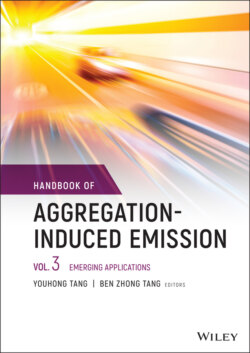Читать книгу Handbook of Aggregation-Induced Emission, Volume 3 - Группа авторов - Страница 30
2.3 Macrocycles and Cages
ОглавлениеMost of the typical AIE‐active molecules such as TPE, hexaphenylsilole (HPS), and their derivatives possess propeller‐shaped structures. In solution, these AIE luminophores are generally achiral due to the rapid conformational switching via intramolecular rotation. In the aggregated state, the intramolecular rotation is restricted; however, the random distribution of P‐type and M‐type conformations can only lead to chiroptical silence. Consequently, it becomes a significant challenge to produce CPL directly from simple AIE luminophores.
In 2016, Zheng et al. reported a pair of TPE tetracycles (P‐33 and M‐33) with stable chirality in a dilute solution (Figure 2.7a) [27]. They prepared the tetracycles by intramolecular cyclization and successfully immobilized the propeller‐shaped conformation of the TPE unit. The helical configurations of the P and M enantiomers were found to be remarkably stable at room temperature and can be isolated by chiral high performance liquid chromatography (HPLC). Since the phenyl rings were fixed by the intramolecular linkers and thus prevented from rotation, the tetracycle showed strong luminescence even in solution. The quantum yield of 33 reached up to 97% in a THF solution and 80% in the aggregated state. Mirror image CD and CPL spectra (Figure 2.7b–d) were observed for the tetracycle enantiomers, with glum of −3.3 × 10−3 (505 nm) and +3.1 × 10−3 (505 nm) for P‐33 and M‐33, respectively, in a THF solution (Figure 2.7c), and −5.0 × 10−3 (500 nm) and +6.2 × 10−3 (500 nm), respectively, in the aggregated state (Figure 2.7d).
Figure 2.7 (a) Molecular structures of TPE tetracycle enantiomers P‐33 and M‐33 and corresponding glum. (b) CD spectra and (c) CPL spectra of P‐33 and M‐33 in a THF solution (1.0 × 10−3 M). (d) CPL spectra of P‐33 and M‐33 in a THF/H2O mixture (fw = 90%).
Source: Reproduced with permission [27]. Copyright 2016, American Chemical Society.
In 2017, Cao’s group prepared two chiral cubic cages 34 and 35 by reversible covalent condensation based on a TPE derivative (Figure 2.8) [28]. Each cage molecule was comprised of six TPE tetra‐aldehyde units and eight triaminoethylamine units. Unlike a single TPE molecule, the TPE units on each face of the cubic cage possessed stable configuration with P or M chirality. The rotation of the phenyl groups in the TPE units was restricted probably due to the strong steric hindrance from the neighboring TPE units. Therefore, the propeller‐shaped configurations of the TPE units were fixed in a cubic cage. By chiral HPLC, two pairs of enantiomers including homodirectional enantiomers (6P‐34 and 6M‐34) and heterodirectional enantiomers (2P4M‐35 and 4P2M‐35) were separated. Further characterizations showed that these cubic cages exhibited strong blue luminescence even in solution due to the rotation restriction of the benzene rings. Besides, the cage enantiomers exhibited mirror image CD and CPL spectra. The homodirectional cages (6P‐34 and 6M‐34) showed a higher CPL activity at 450 nm with glum of ±1.1 × 10−3, and the heterodirectional cages (2P4M‐35 and 4P2M‐35) revealed glum of ±9.3 × 10−4 (450 nm).
Figure 2.8 (a) Synthesis of organic cubes from six TPE tetra‐aldehyde units and eight triaminoethylamine units. Schematic representations of (b) homodirectional cubes 6P‐34 and 6M‐34, and (c) heterodirectional cubes 4P2M‐35 and 2P4M‐35, and corresponding glum.
Source: Reproduced with permission [28]. Copyright 2017, American Chemical Society.
